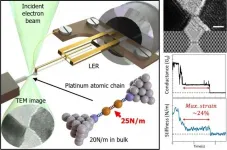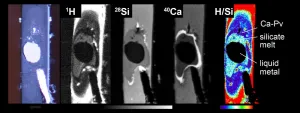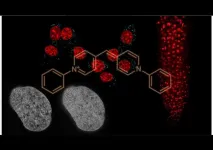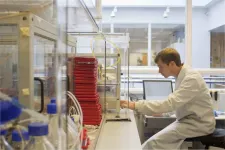New screening method could lead to microbe-based replacements for chemical pesticides
The novel screening method can help scientists identify microorganisms that stimulate plant immune mechanisms without harming the plants themselves
2021-05-14
(Press-News.org) Plants have evolved unique immunity mechanisms that they can activate upon detecting the presence of a pathogen. Interestingly, the presence of some nonpathogenic microorganisms can also prompt a plant to activate its systemic immunity mechanisms, and some studies have shown that pretreating agricultural crops with such "immunity-activating" nonpathogenic microorganisms can leave the crops better prepared to fight off infections from pathogenic microorganisms. In effect, this means that immunity-activating nonpathogenic microorganisms can function like vaccines for plants, providing a low-risk stimulus for the plant's immune system that prepares it for dealing with genuine threats. These are exciting findings for crop scientists because they suggest the possibility of using such pretreatment as a form of biological pest control that would reduce the need for agricultural pesticides.
However, before pretreatment with nonpathogenic microorganisms can become a standard agricultural technology, scientists need a way to screen microorganisms for the ability to stimulate plant immune systems without harming the plants. There is currently no simple method for evaluating the ability of microorganisms to activate plant immune systems. Conventional methods involve the use of whole plants and microorganisms, and this inevitably makes conventional screening a time-consuming and expensive affair. To address this problem, Associate Professor Toshiki Furuya and Professor Kazuyuki Kuchitsu of Tokyo University of Science and their colleagues decided to develop a screening strategy involving cultured plant cells. A description of their method appears in a paper recently published in Scientific Reports.
The first step in this screening strategy involves incubating the candidate microorganism together with BY-2 cells, which are tobacco plant cells known for their rapid and stable growth rates. The next step is to treat the BY-2 cells with cryptogein, which is a protein secreted by fungus-like pathogenic microorganisms that can elicit immune responses from tobacco plants. A key part of the cryptogein-induced immune responses is the production of a class of chemicals called reactive oxygen species (ROS), and scientists can easily measure cryptogein-induced ROS production and use it as a metric for evaluating the effects of the nonpathogenic microorganisms. To put it simply, an effective pretreatment agent will increase the BY-2 cells' ROS production levels (i.e., cause the cells to exhibit stronger immune system activation) in response to cryptogein exposure.
To test the practicability of their screening strategy, Dr. Furuya and his colleagues used the strategy on 29 bacterial strains isolated from the interior of the Japanese mustard spinach plant (Brassica rapa var. perviridis), and they found that 8 strains boosted cryptogein-induced ROS production. They then further tested those 8 strains by applying them to the root tips of seedlings from the Arabidopsis genus, which contains species commonly used as model organisms for studies of plant biology. Interestingly, 2 of the 8 tested strains induced whole-plant resistance to bacterial pathogens.
Based on the proof-of-concept findings concerning those 2 bacterial strains, Dr. Furuya proudly notes that his team's screening method "can streamline the acquisition of microorganisms that activate the immune system of plants." When asked how he envisions the screening method affecting agricultural practices, he explains that he expects his team's screening system "to be a technology that contributes to the practical application and spread of microbial alternatives to chemical pesticides."
In time, the novel screening method developed by Dr. Furuya and team may make it significantly easier for crop scientists create greener agricultural methods that rely on the defense mechanisms that plants themselves have evolved over millions of years.
INFORMATION:
Reference
Titles of original papers: An efficient direct screening system for microorganisms that activate plant immune responses based on plant-microbe interactions using cultured plant cells
Journal: Scientific Reports
DOI: https://doi.org/10.1038/s41598-021-86560-0
About The Tokyo University of Science
Tokyo University of Science (TUS) is a well-known and respected university, and the largest science-specialized private research university in Japan, with four campuses in central Tokyo and its suburbs and in Hokkaido. Established in 1881, the university has continually contributed to Japan's development in science through inculcating the love for science in researchers, technicians, and educators.
With a mission of "Creating science and technology for the harmonious development of nature, human beings, and society", TUS has undertaken a wide range of research from basic to applied science. TUS has embraced a multidisciplinary approach to research and undertaken intensive study in some of today's most vital fields. TUS is a meritocracy where the best in science is recognized and nurtured. It is the only private university in Japan that has produced a Nobel Prize winner and the only private university in Asia to produce Nobel Prize winners within the natural sciences field.
Website: https://www.tus.ac.jp/en/mediarelations/
About Associate Professor Toshiki Furuya from Tokyo University of Science
Dr. Toshiki Furuya, D.Eng., is an Associate Professor within the Department of Applied Biological Science of the Faculty of Science and Technology. He completed his undergraduate and postgraduate education at Waseda University. His key research interests are the biotechnology applications of microorganisms and enzymes, and his work has earned him various awards, including an Excellent Paper Award from the Japanese Society of Biotechnology. He has authored 35 peer-reviewed papers, 17 other papers, and more than 100 conference presentations, and he holds a patent related to the bioproduction of valuable chemicals.
Funding information
This study was supported by the Japan Society for the Promotion of Science and the Institute for Fermentation (Osaka, Japan).
ELSE PRESS RELEASES FROM THIS DATE:
2021-05-14
Researchers at UC San Francisco have observed a new feature of neural activity in the hippocampus - the brain's memory hub - that may explain how this vital brain region combines a diverse range of inputs into a multi-layered memories that can later be recalled.
Using a special "micro-grid" recording device developed by colleagues at Lawrence Livermore National Laboratory (LLNL), the UCSF researchers were able to measure hippocampus activity in study participants undergoing surgery to treat severe epilepsy. They discovered that brain waves travel back and forth across this structure, integrating messages ...
2021-05-14
The international scientific community agrees that the latest findings of an FAU research team will revolutionise the entire chemistry of magnesium. The research team have discovered magnesium, which usually has a double positive charge in chemical compounds, in the elemental zero-oxidation state. They have published their ground-breaking findings in the journal Nature.
In the periodic table of elements, magnesium (Mg) is a metal with low electronegativity, which means it does not easily attract electrons but easily loses both the electrons in its outer shell during chemical reactions. It therefore only exists in nature as a compound ...
2021-05-14
Ishikawa, Japan - Today, many well-studied materials in various fields, such as electronics and catalysis, are close to reaching their practical limits. To further improve upon modern technology and outperform state-of-the-art devices, researchers looking for new functional materials have to push the boundaries and explore more extreme cases. A clear example of this is the study of low-dimensional materials, such as monoatomic layers (2D materials) and monoatomic chains (1D materials).
It has been proved time and time again that low-dimensional materials exhibit exotic properties that are absent in their 3D bulk counterparts. For example, monoatomic chains of metals like gold ...
2021-05-14
High-temperature and high-pressure experiments involving a diamond anvil and chemicals to simulate the core of the young Earth demonstrate for the first time that hydrogen can bond strongly with iron in extreme conditions. This explains the presence of significant amounts of hydrogen in the Earth's core that arrived as water from bombardments billions of years ago.
Given the extreme depths, temperatures and pressures involved, we are not physically able to probe very far into the earth directly. So, in order to peer deep inside the Earth, researchers use techniques involving seismic data to ascertain things like composition and density of subterranean material. Something that has stood out for as long as these kinds of measurements have been taking place is that the core is primarily ...
2021-05-14
The ease with which anyone can create online content for free, especially on social media, has led to superabundance of information being one of the defining characteristics of today's communication systems. This situation has resulted in increasingly intense competition for attention, which has become a scarce good. The researchers from the Complex Systems group (CoSIN3) at the UOC's Internet Interdisciplinary Institute (IN3) María José Palazzi and Albert Solé --professor at the Faculty of Computer Science, Multimedia and Telecommunications?--, led by Javier Borge, have participated in the design of ...
2021-05-14
When it comes to ancient Roman imperial architecture, most people usually have a mental image of white marble statues, columns, or slabs. While it is true that many buildings and squares at that time were decorated with marble, it was frequently not white but colored marble that was employed, such as the green-veined Cipollino Verde, which was extracted on the Greek island of Euboea. Because marble was very expensive, it was often placed in thin slabs as a cladding over other, cheaper stones. "To date, however, no actual remains of marble workshops from the Roman imperial era have been found, so little is known about marble processing during this period," said Professor Cees Passchier ...
2021-05-14
An international research team analyzed a database of more than 1000 supernova explosions and found that models for the expansion of the Universe best match the data when a new time dependent variation is introduced. If proven correct with future, higher-quality data from the Subaru Telescope and other observatories, these results could indicate still unknown physics working on the cosmic scale.
Edwin Hubble's observations over 90 years ago showing the expansion of the Universe remain a cornerstone of modern astrophysics. But when you get into the details ...
2021-05-14
A group of scientists at Nagoya University, Japan, have developed an incredibly versatile DNA fluorescent dye, named 'Kakshine' after a former NU student of its members, Dr Kakishi Uno, but it also means to make the nucleus shine brightly, since the nucleus is pronounced 'Kaku' in Japanese. Dr Uno, with Dr Yoshikatsu Sato and Nagisa Sugimoto, the other two members of the research team at the Institute of Transformative Bio-Molecules (ITbM), succeeded in developing a DNA binding fluorescent dye with the pyrido cyanine backbone, which satisfied the three principal qualities required of such a dye - that it have high selectivity for DNA, ability to use visible light with limited phototoxicity, ...
2021-05-14
A new method to analyse the blood thinning drug Heparin has been developed that can pinpoint contaminants more accurately and quickly, providing greater quality control and safety.
An interdisciplinary team from the University of Nottingham's Schools of Pharmacy and Medicine have used the latest chemical imaging technology to identify contaminants in Heparin at the nanoscale, a discovery that manufacturers could use to improve the quality and safety of this widely used anticoagulant drug. The research has been published in Communications Chemistry.
Heparin is naturally occurring glycosaminoglycan ...
2021-05-14
ATS 2021, New York, NY - The use of e-cigarettes is associated with wheezing and shortness of breath in young adults and adolescents, even in those who don't smoke cigarettes or marijuana, according to research presented at the ATS 2021 International Conference.
Alayna P. Tackett, PhD, assistant professor of preventive medicine, University of Southern California Keck School of Medicine, and colleagues conducted a web-based survey of 2,931 adolescents and young adults (average age: 18.9) with questions on the use of e-cigarettes, cigarettes and cannabis, along with self-reported asthma diagnosis and respiratory symptoms, over the previous 30 days. The survey was fielded between August 6 and 30, 2020 among a national convenience sample of youth and young ...
LAST 30 PRESS RELEASES:
[Press-News.org] New screening method could lead to microbe-based replacements for chemical pesticides
The novel screening method can help scientists identify microorganisms that stimulate plant immune mechanisms without harming the plants themselves





